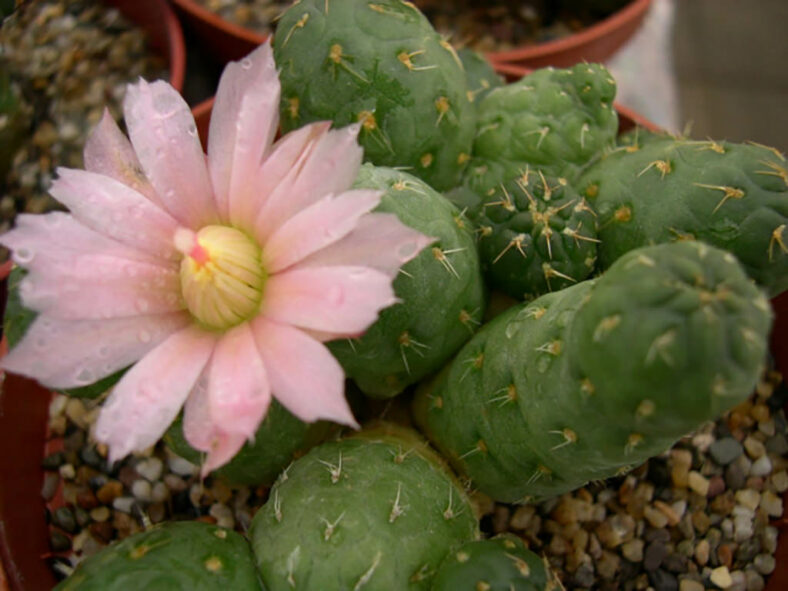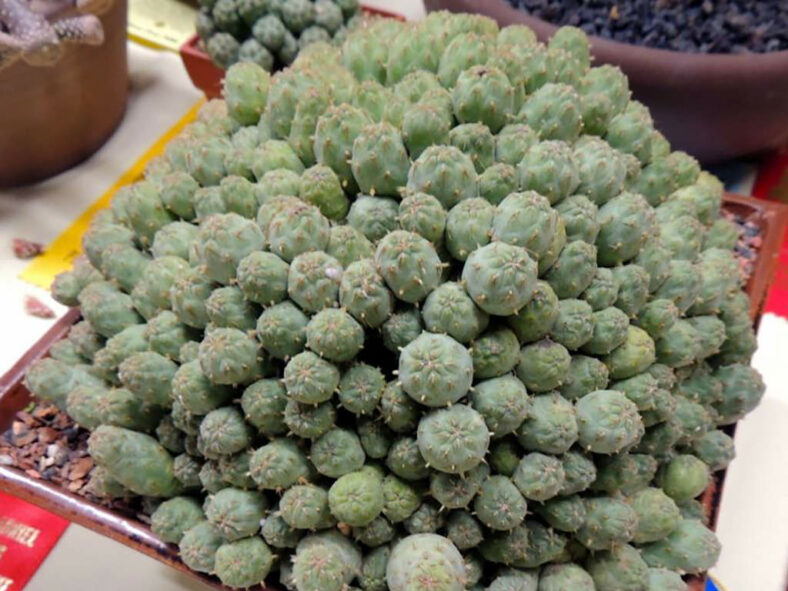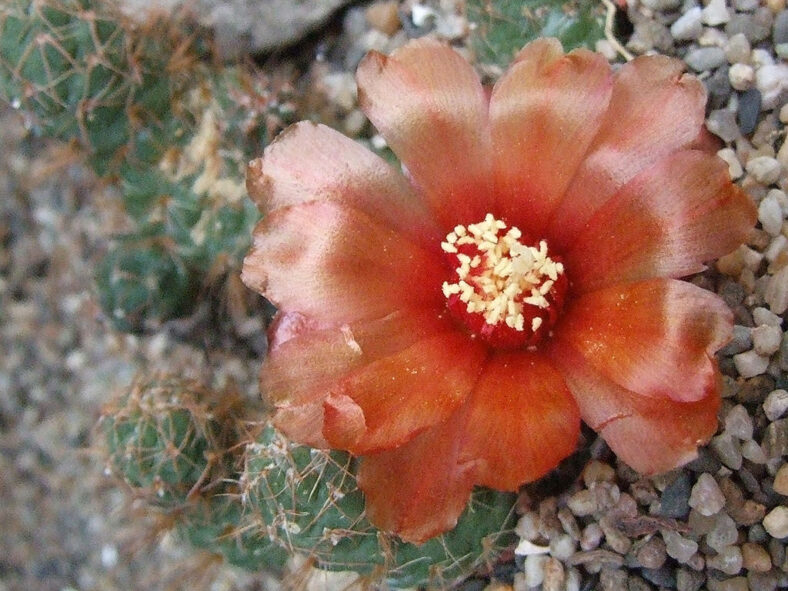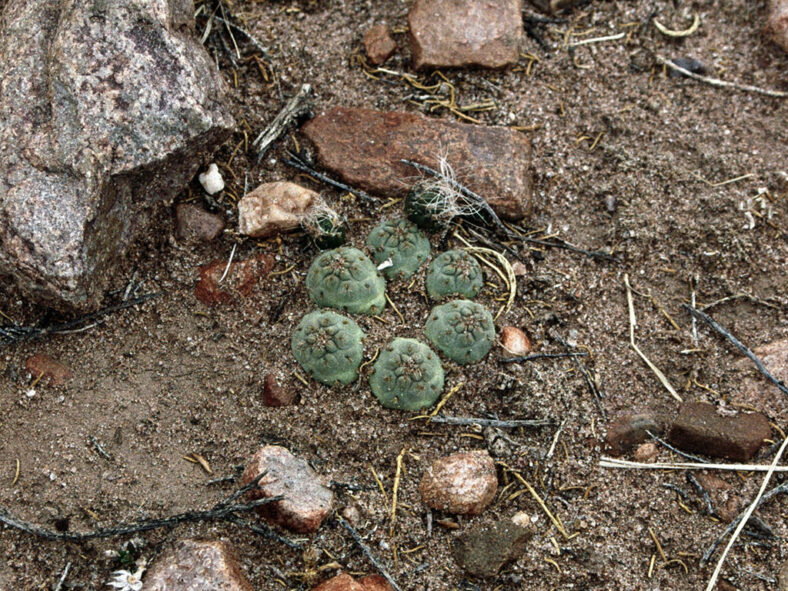Cumulopuntia subterranea is a variable species first described by Edward Frederick Anderson in 1905 as Opuntia subterranea.
Scientific Name
Cumulopuntia subterranea (R.E.Fr.) F.Ritter
Synonym(s)
Cumulopuntia subterranea subsp. subterranea, Maihueniopsis subterranea, Opuntia subterranea, Pseudotephrocactus subterraneus, Puna subterranea, Tephrocactus subterraneus
Scientific Classification
Family: Cactaceae
Subfamily: Opuntioideae
Tribe: Austrocylindropuntieae
Genus: Cumulopuntia
Etymology
The specific epithet "subterranea (pronounced sub-ter-RAY-nee-uh)" means "underground, subterranean" and refers to the stems of this species that grow almost entirely underground in its native habitat.
Origin
Cumulopuntia subterranea is native to Argentina (Jujuy) and Bolivia (Potosí). It can be found in sandy or rocky soils at high elevations, from 6,560 to 16,400 feet (2,000 to 5,000 m).
Description
Cumulopuntia subterranea, also known as Puna subterranea or Maihueniopsis subterranea, is a dwarf cactus with stems that consist of a few egg-shaped segments with somewhat rhomboid tubercles and short spines more or less pressed close to the stem. The plant has a deep tuberous root and can form a clump of up to 100 stems as it matures. The stem segments are usually about 1.6 inches (4 cm) tall and 0.7 inches (1.8 cm) in diameter. They range from grayish-green to brownish stems when exposed to full sun. Each areole bears 1 to 10 spines, and tiny glochids are sometimes present only on the lower areoles of the stem segments.
During the summer, beautiful flowers bloom at the tips of the upper stem segments. The colors of the flowers can range from brown and deep rose red to yellowish-pink, pale pink, and nearly white. The flowers can reach up to 1.2 inches (3 cm) long and have a diameter larger than the stem segments. The spherical fruits can grow up to 0.6 inches (1.5 cm) in diameter.

How to Grow and Care for Cumulopuntia subterranea
Light: Cumulopuntia subterranea thrives in full sun, but some shade during midday and afternoon can prevent sunburn during summer. A window that receives sunlight 6 hours a day works best when grown indoors.
Soil: This cactus requires a soil mix that drains well. So, use a commercial cactus potting mix or create your own.
Temperature: Extremely tolerant of high temperatures, Cumulopuntia subterranea prefers cooler temperatures in winter. It grows best in USDA Plant Hardiness Zones 9b to 11b, with average minimum winter temperatures ranging from 25 to 40 °F (-3.9 to 4.4 °C).
Watering: From spring to fall, water moderately and let the soil dry out completely before watering again. In most areas, rainfall will be enough for established plants. If potted, never let the container sit in water. During the winter, suspend the watering.
Fertilizing: Cumulopuntia subterranea does not need fertilizer when planted in the ground. However, when grown in a container, the plant will benefit from water-soluble fertilizer during the growing season. Suspend the feeding during the winter when it goes dormant.
Repotting: Repot only when the cactus becomes potbound or is too large and unstable in its container. Choose a slightly larger container with drainage holes at the bottom. The best time for repotting is late winter or early spring.
Propagation: You can propagate Cumulopuntia subterranea by stem segments or seeds. Using stem segments is the easiest method and yields faster results. For best results, take stem segments in early summer. Sow the seeds in late spring.
Learn more at How to Grow and Care for Opuntia.
Toxicity of Cumulopuntia subterranea
Cumulopuntia subterranea is not toxic to humans or pets. However, keep the plant away from pets and children as it has harmful spines and glochids that may cause skin irritation.
Links
- Back to genus Cumulopuntia
- Succupedia: Browse succulents by Scientific Name, Common Name, Genus, Family, USDA Hardiness Zone, Origin, or cacti by Genus
Photo Gallery
Click on a photo to see a larger version.


